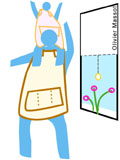- Publications:
- Newsletter:
- How-To Tutorials:
- Consumer Guides:
- Related:

Easy Home Fix Its
Home Repair Tips, Part 2

“Easy Home Fix Its”
Solutions to Your Most Annoying Problems
By Al Ubell and Label Shulman
Published January 4, 1985 - Family Circle Magazine
Updated August 12, 2005

You asked us the questions-now we've got the answers. Whether it's fixing a small hole in your window screen or a large one in your driveway, we give you simple remedies you can do yourself. And for additional how to fix it tips for kitchen, bathroom, basement and general living areas review the 1984 article 20 Easy Fix-Its.
10 Solutions to Basic Home Repairs
- Window Shade Repair
- Wood Paneling Removal
- Ceiling Stains
- Leaky Roofing
- Leaky/Wet Central Air Ducts
- Broken Wind Screen
- Leaky Faucet
- Wobbly Chair
- Driveway Pot Hole
- Broken Door Lock
Window Shade Repair
Question: My kids are always pulling the window shades off the wooden rollers. I've tried stapling and using thumb tacks to put the shade back on, but it still won't hold. What can I do? - A.F., Tuscaloosa, Ala.
Answer: Attach a piece of 1″ or 2″ wide tape-cloth, plastic, adhesive or duct-long the entire top edge of the window shade, leaving half the tape's width exposed for attachment to the roller. Line up the top of the shade with the factory-marked line on the roller and affix by pressing down on the remaining half of the tape. Make sure that the shade wraps around the roller in the same direction as it did originally.
Wood Paneling Removal
Question: We want to paint a room that now has wood paneling nailed to plaster walls. We're worried that if we remove the paneling, it will leave big holes in the walls. What should we do? - M.D., Little Neck, N.Y.
Answer: Removing nailed or glued panels from any wall-plaster, wallboard or sheet rock may result in extensive damage to the wall surface. You'll probably have to spackle and replaster the wall before you paint it-a time-consuming, messy and expensive job.
There is an easier way: Simply paint over the paneling. First, wash the surface with washing soda (available at hardware stores) to remove grease, grime and wax. Let dry, sand lightly with a fine to medium-grade sandpaper (100 to 120 grit). Wipe excess dust off with a dry cloth, and you're ready to paint. If the paneling is grooved, it may be necessary to spackle these indentations first.
Ceiling Stains
Question: Our once-leaky roof left a stain on our ceiling. We used several coats of paint to cover the stain, but the stain reappeared. What can we do? - B.F., Newton, Mass.
Answer: The staining is caused by silt and grease embedded in the plaster. To correct the condition, first sand and scrape the area thoroughly to make the surface as smooth and clean as possible. Then apply two coats of aluminum paint to the sanded area. When it's dry, reap-ply original color paint to match your ceiling.
Leaky Roofing
Question: Whenever it rains, water cascades over the roof gutters down the side of my house. The water is rotting the exterior shingles and leaking into my home. How can I prevent this? - L.R., Atlanta, Mich.
Answer: Most likely, the gutters on your house are secured directly to the building, instead of to an extended roof eave. You can stop your water problem by creating a roof extension to which the gutters are then attached. Remove the gutters and using galvanized nails, secure a double thickness of 2″ x 6″ lumber to the existing fascia board (the band of wood between the top of the exterior wall and the projecting eave). Next, add roofing shingles to extend over the new addition. Reattach the gutters. This creates a small soffit or overhang, which will prevent water from cascading directly onto the house and leaking inside.
Leaky or Wet Central Air Ducts
Question: Every time we turn on the heating system we can hear dripping inside the ceiling ventilators. The sound is driving us crazy! What causes this, and how can we stop it? - P.K., Oklahoma City, Okla.
Answer: The duct work from the central heating system that passes through the attic space is probably not insulated. The heated air from the furnace, which flows through the ducts, carries moisture. The cold air in the attic causes this moisture to condense on the metal duct work and then to drip. To correct the problem, wrap the duct work with at least 2″ to 3″ of “faced” fiberglass insulation. Make sure the vapor barrier facing (usually aluminum, plastic film or heavy paper lined with asphalt) is exposed to the attic area. All insulation seams should be carefully sealed with duct tape.
Broken Wind Screen
Question: We've got small holes in our window screens. Is there any way we can fix them, or do we have to replace all the screens? - L.S., St. Paul, Minn.
Answer: Most small holes can be easily repaired with a drop or two of clear nail polish. First, cut off any broken wires that stick out. Then, apply the nail polish to the hole on both sides of the screen to seal it.
If the screen has a long cut, you can easily sew it up with some plastic sewing thread or very thin fishing line. Use an overhand stitch and be careful not to pull the thread too tightly, or it may tear the screen somewhere else.
Large holes will require a patch. You can use either an old piece of screening or a small piece purchased from your local hardware store. Cut a patch about 1″ larger than the hole. Using plastic thread or very thin fishing line, sew the patch over the hole with a running stitch. Seal the patch on all sides by applying clear nail polish.
Leaky Faucet
Question: My faucet handles leak water. How do I fix this? - J.N., Wilmette, III.
Answer: This is one of the most common plumbing problems-and the easiest to fix. Using a smooth-jawed fixed or adjustable wrench, simply tighten the hexagon-shaped nut (see left) under the handle on the valve stem. If you're worried about scratching the finish on the packing nut, wrap some masking or adhesive tape around it before you tighten.
If the faucet becomes difficult to open after you've tightened the nut and the leak persists, the problem is with the packing material under the nut itself. You'll need to replace the packing. Turn off the water to the faucet by shutting off the cut-off valve under the sink. Remove the screw cover, the faucet handle and then loosen the packing nut in a counterclockwise direction with the smooth-jawed wrench. Remove the nut. Using a small knife or screwdriver, take out the old, deteriorated packing. Take the packing nut to a hardware store and buy a new packing washer. Reassemble the faucet (new packing, nut and faucet handle in that order). Turn on the water valve and test your faucet.
Wobbly Chair
Question: I recently bought a beautiful antique chair, but one of the legs is loose and wobbly. How can I fix it? - C.K., Covington, KY.
Answer: Most old furniture was assembled with animal glues, which can dry out and crack. This is probably what's caused the chair leg to come loose.
To repair it, all you need are wood carpenter's glue (available in any hardware store), a hammer or mallet and a damp cloth. Remove the leg of the chair and using a penknife, scratch out the old dried-up glue in the joint. It may be necessary to scrape out extra glue from any rungs, which may also be attached to the leg. You must remove all the old glue, before applying new adhesive.
To refasten, thoroughly apply carpenter's wood glue to all pieces that must be joined together-joint holes, dowel ends, rung ends and leg ends. Tap all parts of the chair leg to the base with a mallet, hammer or block of wood, until any excess glue oozes out of each joint. Wipe off excess glue with a damp cloth and set the chair on its legs on a level surface to ensure the legs are aligned properly. If the loose leg is not even, load the chair with heavy books or weights to help force the leg all the way into the joint and to level out the chair before the glue sets. Let glue dry overnight.
Driveway Pot Hole
Question: How can I fix a pothole in my driveway? - M.M., Hanover, N.H.
Answer: It's easy. All you need are asphalt cold patch and liquid tar, both of which can be purchased at home centers or lumber yards. If the hole is very large or deep (see right), you'll need some gravel, too.
First, sweep the hole clean of loose debris. Brush some of the liquid tar in the hole with an old paintbrush, paying particular attention to the edges. Next, using a shovel, fill the hole with cold patch, making a mound at least 1″ higher than the surface of the driveway. (If the pothole is large, fill it with gravel before adding the cold patch.) Pound down the patching material with the shovel, or place a wide wooden board over the patch and slowly drive your car wheels over it to pack it until the patch is flat and even with the driveway.
Broken Door Lock
Question: We just bought a “new” old house, and several of the door locks are loose. Can we fix these ourselves? - P.D., Lawrence, Kan.
Answer: Of course you can. Chances are, the strike bolt holding plate (see below) on the edge of the door has loose screws. Remove the screws. Dip some wood toothpicks into glue and then insert them into each screw hole until it is filled. Break the toothpicks as close as possible to the edge of the plate. Allow the glue to dry. Re-insert the screws and tighten in a clockwise direction.
If the round plate (escutcheon plate) at the doorknob is also loose, tighten each of the two screws with a Phillips screwdriver. The screw heads may be on either the inside or outside face of the door. Do not over tighten - this could cause binding or jamming.

Copyright © Alvin Ubell, Label Shulman & Family Circle Magazine - 1983
Accurate Building Inspectors ®
www.AccurateBuilding.com




